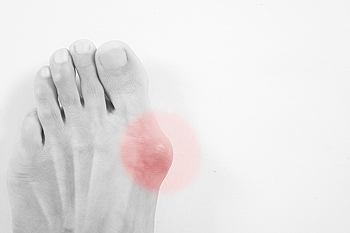Connect With Us
Blog
Items filtered by date: February 2020
Different Reasons a Bunion May Develop
 Bunions, otherwise recognized as a deformity of the big toe, can be incredibly painful when left untreated. They may easily be diagnosed by looking for a bony protrusion on the side of the big toe, and are typically more common among women and elderly patients. However, there are many reasons why someone may develop a bunion, one of those reasons being genetics. Another contributing factor may have to do with your shoes. Those who commonly wear constraining footwear, such as high heels, or cowboy boots, for extended periods of time may be more likely to develop a bunion. Injuries to the foot, as well as arthritis, can both increase your risk of developing a bunion. To help find relief from the pain bunions typically cause, it is suggested that you wear custom orthotics. For more information on treating bunions and how orthotics may help, please consult with a podiatrist for professional care.
Bunions, otherwise recognized as a deformity of the big toe, can be incredibly painful when left untreated. They may easily be diagnosed by looking for a bony protrusion on the side of the big toe, and are typically more common among women and elderly patients. However, there are many reasons why someone may develop a bunion, one of those reasons being genetics. Another contributing factor may have to do with your shoes. Those who commonly wear constraining footwear, such as high heels, or cowboy boots, for extended periods of time may be more likely to develop a bunion. Injuries to the foot, as well as arthritis, can both increase your risk of developing a bunion. To help find relief from the pain bunions typically cause, it is suggested that you wear custom orthotics. For more information on treating bunions and how orthotics may help, please consult with a podiatrist for professional care.
If you are suffering from bunion pain, contact Scott Matthews, DPM, MD of Salem Foot Care . Our doctor can provide the care you need to keep you pain-free and on your feet.
What Is a Bunion?
Bunions are painful bony bumps that usually develop on the inside of the foot at the joint of the big toe. As the deformity increases over time, it may become painful to walk and wear shoes. Women are more likely to exacerbate existing bunions since they often wear tight, narrow shoes that shift their toes together. Bunion pain can be relieved by wearing wider shoes with enough room for the toes.
Causes
- Genetics – some people inherit feet that are more prone to bunion development
- Inflammatory Conditions - rheumatoid arthritis and polio may cause bunion development
Symptoms
- Redness and inflammation
- Pain and tenderness
- Callus or corns on the bump
- Restricted motion in the big toe
In order to diagnose your bunion, your podiatrist may ask about your medical history, symptoms, and general health. Your doctor might also order an x-ray to take a closer look at your feet. Nonsurgical treatment options include orthotics, padding, icing, changes in footwear, and medication. If nonsurgical treatments don’t alleviate your bunion pain, surgery may be necessary.
If you have any questions, please feel free to contact our office located in Wikesboro, NC . We offer the newest diagnostic and treatment technologies for all your foot care needs.
What Are the Symptoms of Hammertoe?
 When the middle joint in a toe looks deformed, it may be indicative of a condition that is known as hammertoe. Hammertoe occurs as a result of an imbalance in the soft tissues of the affected toe, and may cause swelling and discomfort. Additional symptoms may consist of redness surrounding the toe, and difficulty moving or straightening the toe. The affected toe typically bends downward, resembling a hammer, and a corn may form on top of it as shoes are worn as well. This condition may happen from a genetic muscle imbalance, if shoes that are worn have inadequate room for the toes to move freely in, or if the toe has endured an injury. There are several ways to treat hammertoe. If you are afflicted with this condition, it is strongly advised that you seek the counsel of a podiatrist who can begin the best type of treatment for you.
When the middle joint in a toe looks deformed, it may be indicative of a condition that is known as hammertoe. Hammertoe occurs as a result of an imbalance in the soft tissues of the affected toe, and may cause swelling and discomfort. Additional symptoms may consist of redness surrounding the toe, and difficulty moving or straightening the toe. The affected toe typically bends downward, resembling a hammer, and a corn may form on top of it as shoes are worn as well. This condition may happen from a genetic muscle imbalance, if shoes that are worn have inadequate room for the toes to move freely in, or if the toe has endured an injury. There are several ways to treat hammertoe. If you are afflicted with this condition, it is strongly advised that you seek the counsel of a podiatrist who can begin the best type of treatment for you.
Hammertoes can be a painful condition to live with. For more information, contact Scott Matthews, DPM, MD of Salem Foot Care . Our doctor will answer any of your foot- and ankle-related questions.
Hammertoe
Hammertoe is a foot deformity that occurs due to an imbalance in the muscles, tendons, or ligaments that normally hold the toe straight. It can be caused by the type of shoes you wear, your foot structure, trauma, and certain disease processes.
Symptoms
- Painful and/or difficult toe movement
- Swelling
- Joint stiffness
- Calluses/Corns
- Physical deformity
Risk Factors
- Age – The risk of hammertoe increases with age
- Sex – Women are more likely to have hammertoe compared to men
- Toe Length – You are more likely to develop hammertoe if your second toe is longer than your big toe
- Certain Diseases – Arthritis and diabetes may make you more likely to develop hammertoe
Treatment
If you have hammertoe, you should change into a more comfortable shoe that provides enough room for your toes. Exercises such as picking up marbles may strengthen and stretch your toe muscles. Nevertheless, it is important to seek assistance from a podiatrist in order to determine the severity of your hammertoe and see which treatment option will work best for you.
If you have any questions, please feel free to contact our office located in Wikesboro, NC . We offer the newest diagnostic and treatment technologies for all your foot care needs.
Possible Dangers of Wearing High Heels
 Many women enjoy wearing high heels. They can make the feet and legs look slender, as well as add style to many clothing choices. Despite their popularity, they have been linked to causing damage to the feet. It may be easier to trip and sprain an ankle while wearing this type of shoe, and the muscles in the feet may become strained as well. Additionally, wearing high heels that do not have ample room for the toes to move freely in may cause bunions or hammertoes to develop. Some of these conditions may be prevented by alternating between high heels, and shoes that have adequate support. If you would like more information about how high heels can affect the feet, please consult with a podiatrist.
Many women enjoy wearing high heels. They can make the feet and legs look slender, as well as add style to many clothing choices. Despite their popularity, they have been linked to causing damage to the feet. It may be easier to trip and sprain an ankle while wearing this type of shoe, and the muscles in the feet may become strained as well. Additionally, wearing high heels that do not have ample room for the toes to move freely in may cause bunions or hammertoes to develop. Some of these conditions may be prevented by alternating between high heels, and shoes that have adequate support. If you would like more information about how high heels can affect the feet, please consult with a podiatrist.
High heels have a history of causing foot and ankle problems. If you have any concerns about your feet or ankles, contact Scott Matthews, DPM, MD from Salem Foot Care . Our doctor can provide the care you need to keep you pain-free and on your feet.
Effects of High Heels on the Feet
High heels are popular shoes among women because of their many styles and societal appeal. Despite this, high heels can still cause many health problems if worn too frequently.
Which Parts of My Body Will Be Affected by High Heels?
- Ankle Joints
- Achilles Tendon – May shorten and stiffen with prolonged wear
- Balls of the Feet
- Knees – Heels cause the knees to bend constantly, creating stress on them
- Back – They decrease the spine’s ability to absorb shock, which may lead to back pain. The vertebrae of the lower back may compress.
What Kinds of Foot Problems Can Develop from Wearing High Heels?
- Corns
- Calluses
- Hammertoe
- Bunions
- Morton’s Neuroma
- Plantar Fasciitis
How Can I Still Wear High Heels and Maintain Foot Health?
If you want to wear high heeled shoes, make sure that you are not wearing them every day, as this will help prevent long term physical problems. Try wearing thicker heels as opposed to stilettos to distribute weight more evenly across the feet. Always make sure you are wearing the proper shoes for the right occasion, such as sneakers for exercising. If you walk to work, try carrying your heels with you and changing into them once you arrive at work. Adding inserts to your heels can help cushion your feet and absorb shock. Full foot inserts or metatarsal pads are available.
If you have any questions please feel free to contact our office located in Wikesboro, NC . We offer the newest diagnostic and treatment technologies for all your foot and ankle needs.
How Ankle Sprains Can Cause You Pain
 There are many different reasons for a person to experience ankle pain. One of the most common reasons is due to having an ankle sprain. While ankle sprains are quite typical within the sports community, they may still occur during everyday activities. If the ligaments of the ankle are stretched much greater than normal, they will become injured. This is typically caused by the foot turning inward. Along with pain, other common symptoms related to ankle sprains include inflammation, swelling, redness, and warmth near the affected area. In order to make sure you’re correctly caring for your ankle pain, we recommend you consult with a podiatrist for a proper diagnosis and advised treatment plan.
There are many different reasons for a person to experience ankle pain. One of the most common reasons is due to having an ankle sprain. While ankle sprains are quite typical within the sports community, they may still occur during everyday activities. If the ligaments of the ankle are stretched much greater than normal, they will become injured. This is typically caused by the foot turning inward. Along with pain, other common symptoms related to ankle sprains include inflammation, swelling, redness, and warmth near the affected area. In order to make sure you’re correctly caring for your ankle pain, we recommend you consult with a podiatrist for a proper diagnosis and advised treatment plan.
Ankle pain can be caused by a number of problems and may be potentially serious. If you have ankle pain, consult with Scott Matthews, DPM, MD from Salem Foot Care . Our doctor will assess your condition and provide you with quality foot and ankle treatment.
Ankle pain is any condition that causes pain in the ankle. Due to the fact that the ankle consists of tendons, muscles, bones, and ligaments, ankle pain can come from a number of different conditions.
Causes
The most common causes of ankle pain include:
- Types of arthritis (rheumatoid, osteoarthritis, and gout)
- Ankle sprains
- Broken ankles
- Achilles tendinitis
- Achilles tendon rupture
- Stress fractures
- Bursitis
- Tarsal tunnel syndrome
- Plantar fasciitis
Symptoms
Symptoms of ankle injury vary based upon the condition. Pain may include general pain and discomfort, swelling, aching, redness, bruising, burning or stabbing sensations, and/or loss of sensation.
Diagnosis
Due to the wide variety of potential causes of ankle pain, podiatrists will utilize a number of different methods to properly diagnose ankle pain. This can include asking for personal and family medical histories and of any recent injuries. Further diagnosis may include sensation tests, a physical examination, and potentially x-rays or other imaging tests.
Treatment
Just as the range of causes varies widely, so do treatments. Some more common treatments are rest, ice packs, keeping pressure off the foot, orthotics and braces, medication for inflammation and pain, and surgery.
If you have any questions, please feel free to contact our office located in Wikesboro, NC . We offer the newest diagnostic and treatment technologies for all your foot care needs.
Blog Archives
- March 2025
- February 2025
- January 2025
- December 2024
- November 2024
- October 2024
- September 2024
- August 2024
- July 2024
- June 2024
- May 2024
- April 2024
- March 2024
- February 2024
- January 2024
- December 2023
- November 2023
- October 2023
- September 2023
- August 2023
- July 2023
- June 2023
- May 2023
- April 2023
- March 2023
- February 2023
- January 2023
- December 2022
- November 2022
- October 2022
- September 2022
- August 2022
- July 2022
- June 2022
- May 2022
- April 2022
- March 2022
- February 2022
- January 2022
- December 2021
- November 2021
- October 2021
- September 2021
- August 2021
- July 2021
- June 2021
- May 2021
- April 2021
- March 2021
- February 2021
- January 2021
- December 2020
- November 2020
- October 2020
- September 2020
- August 2020
- July 2020
- June 2020
- May 2020
- April 2020
- March 2020
- February 2020
- January 2020
- December 2019
- November 2019
- October 2019
- September 2019
- August 2019
- July 2019
- June 2019
- May 2019
- April 2019
- March 2019
- February 2019
- January 2019
- December 2018
- November 2018
- October 2018
- September 2018
- August 2018
- July 2018
- June 2018
- May 2018

